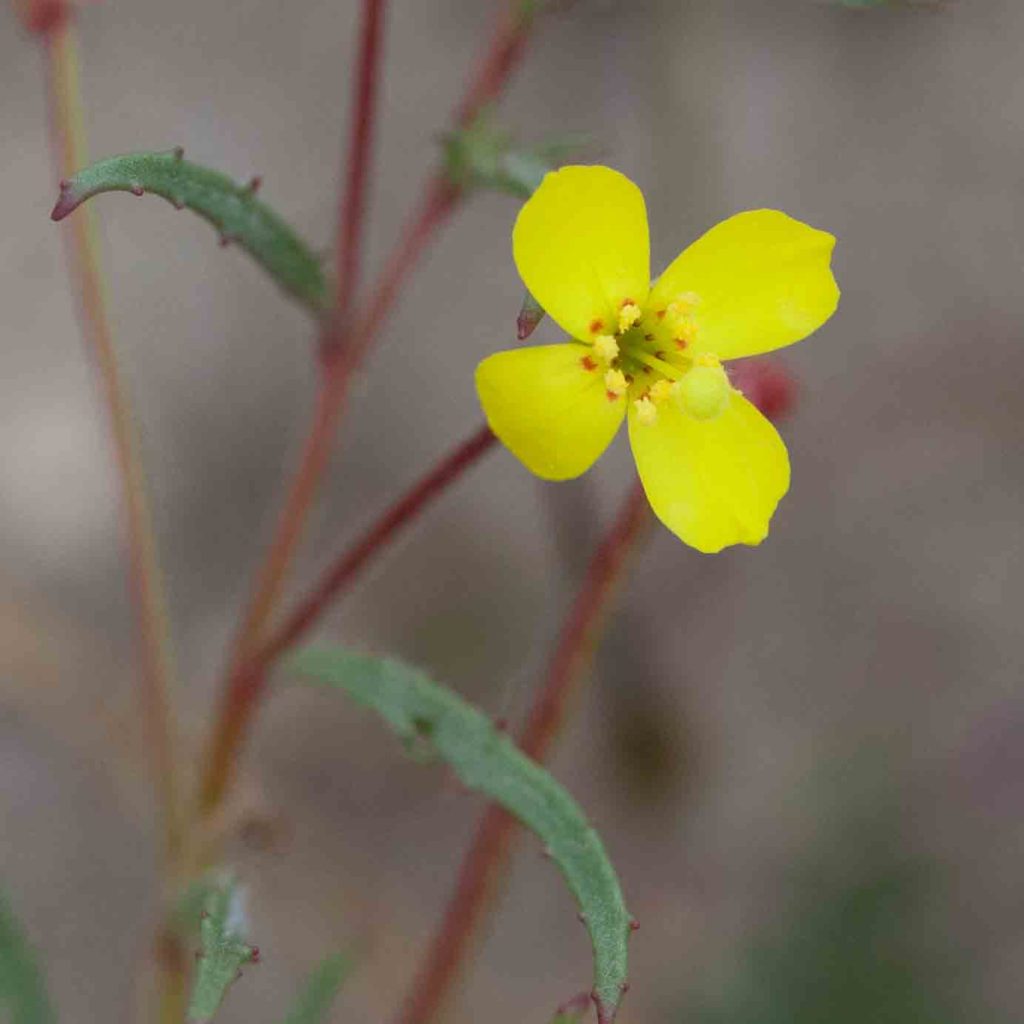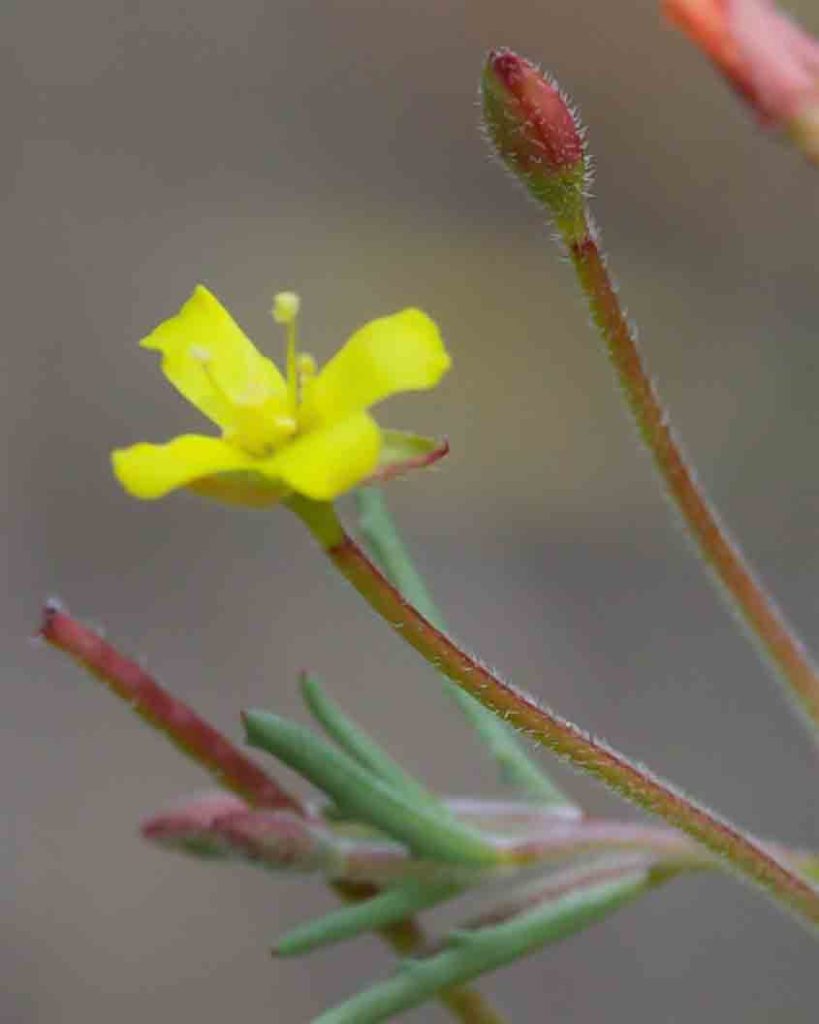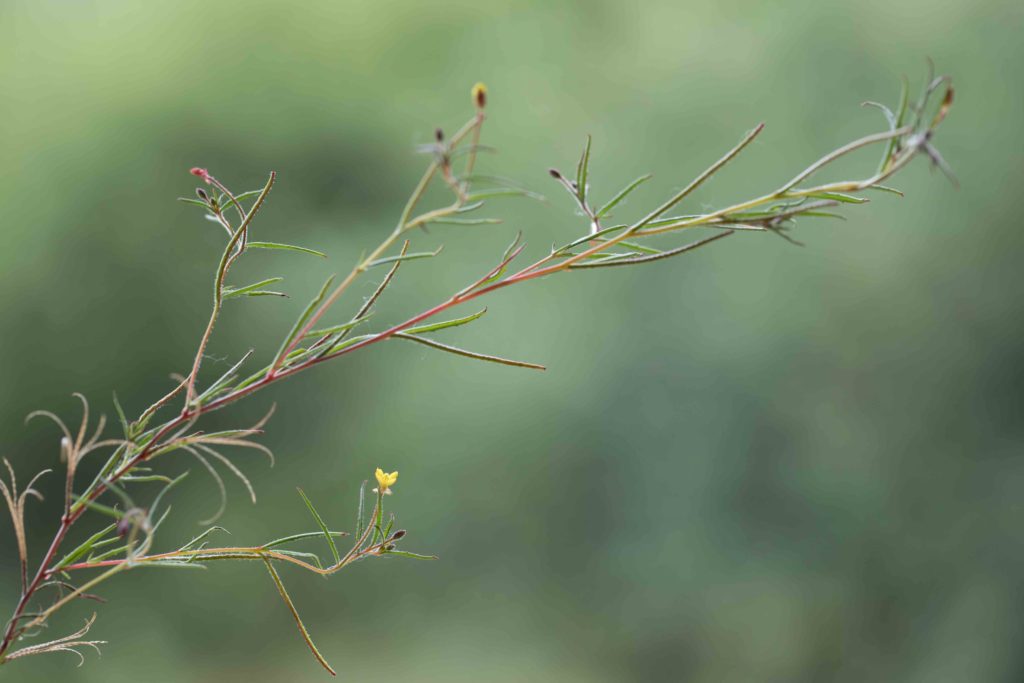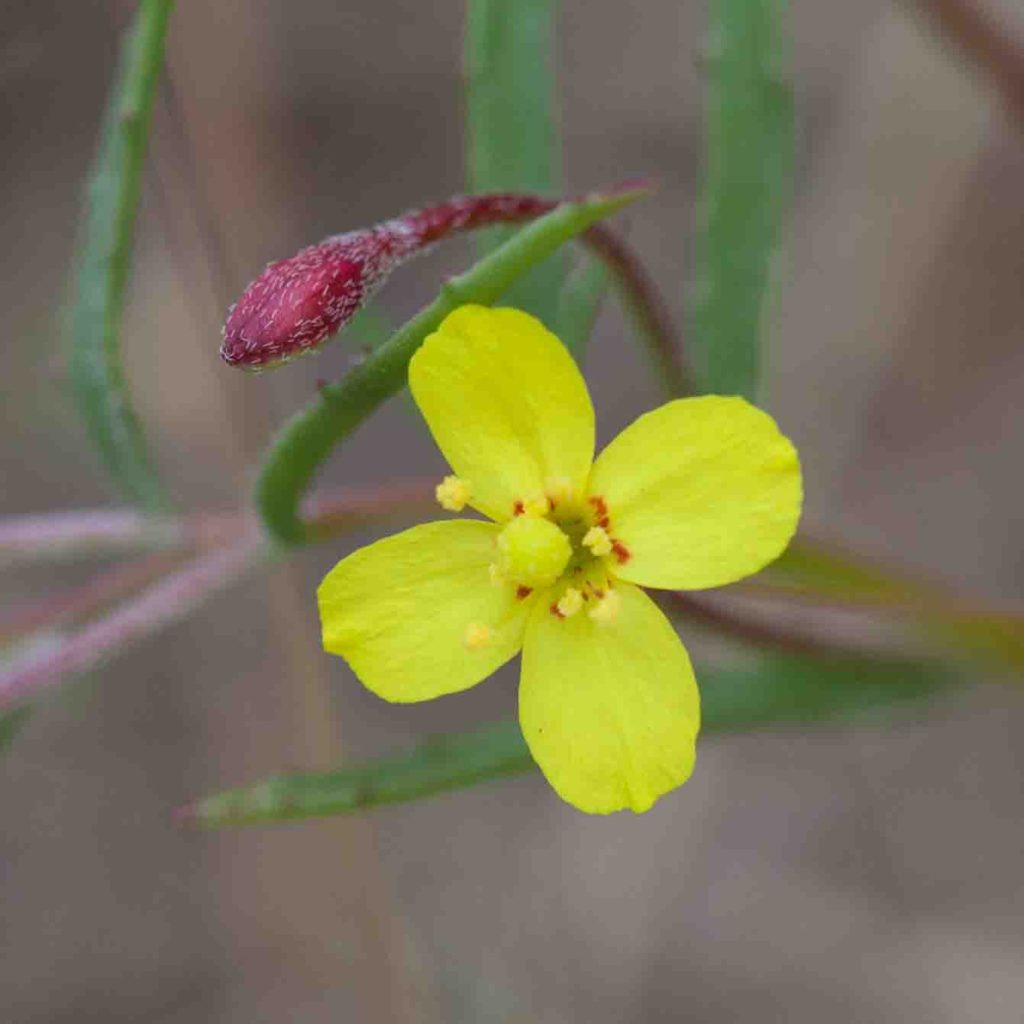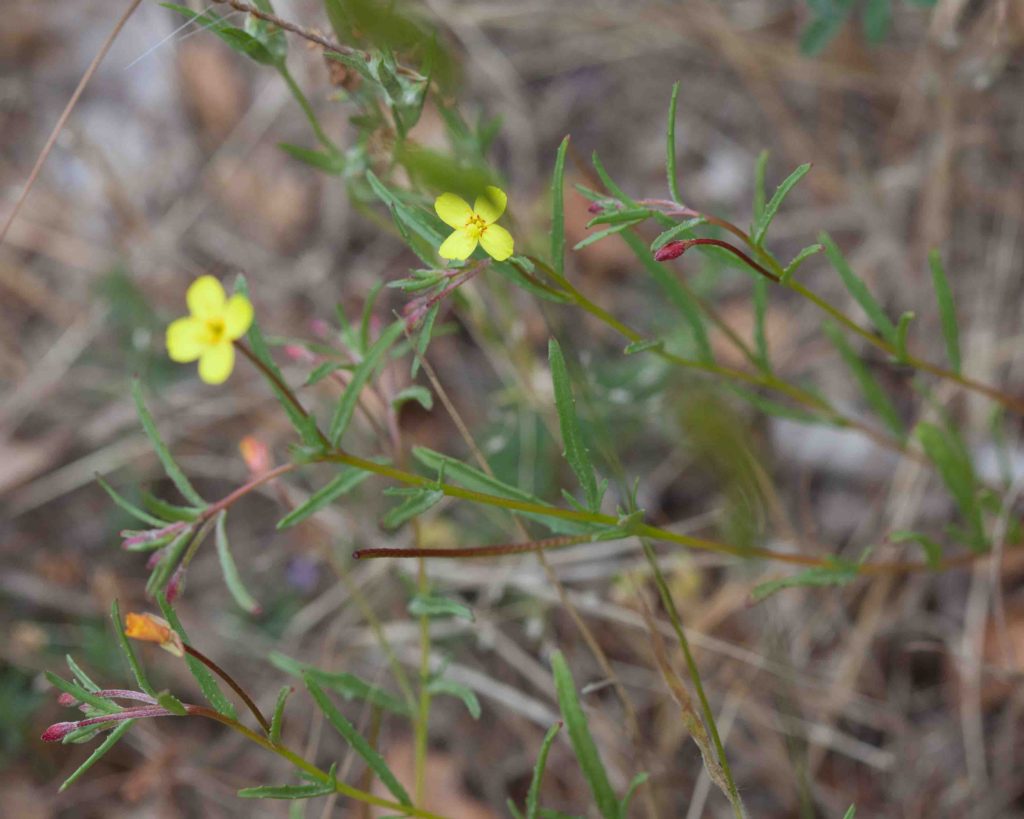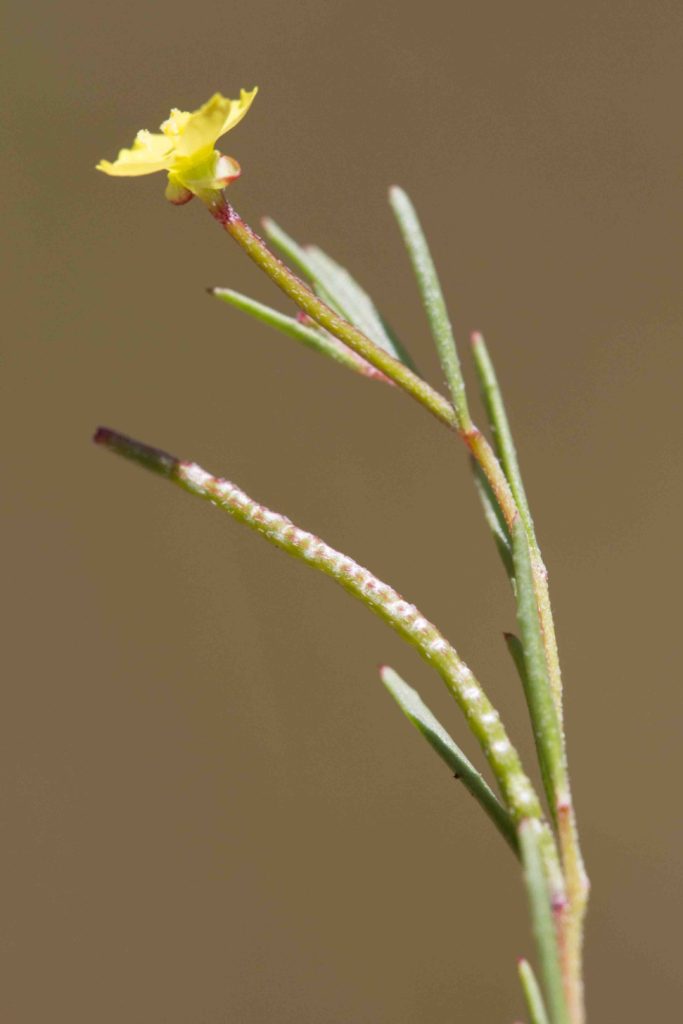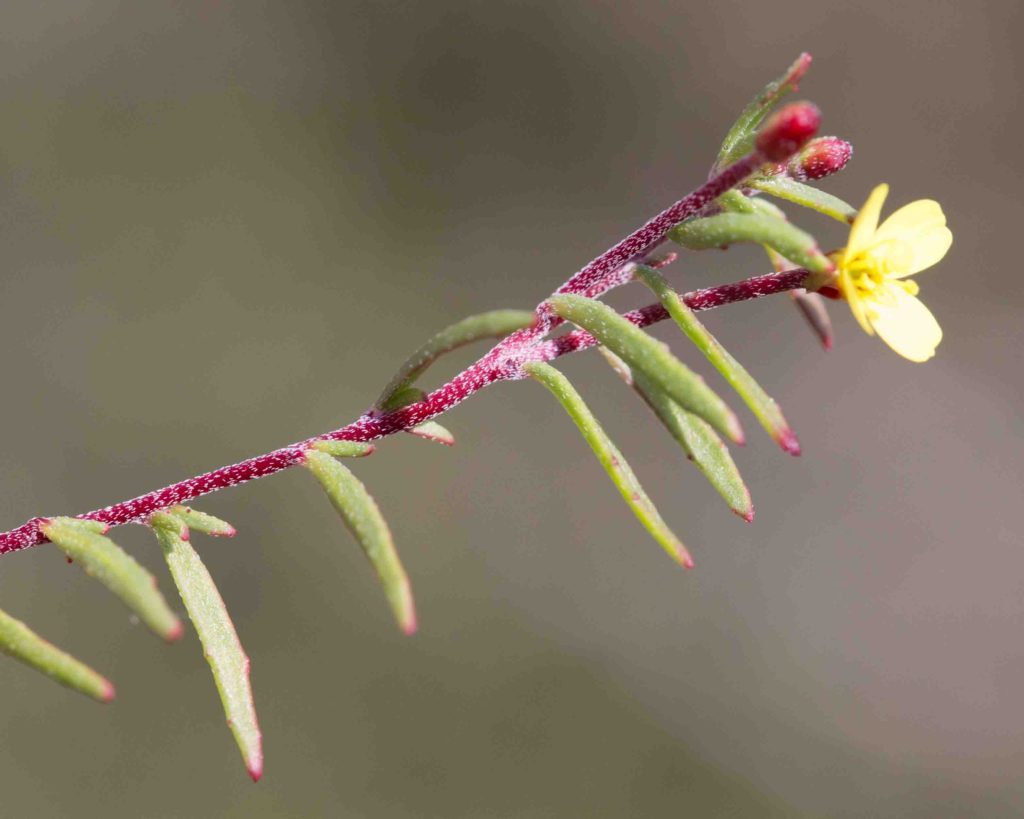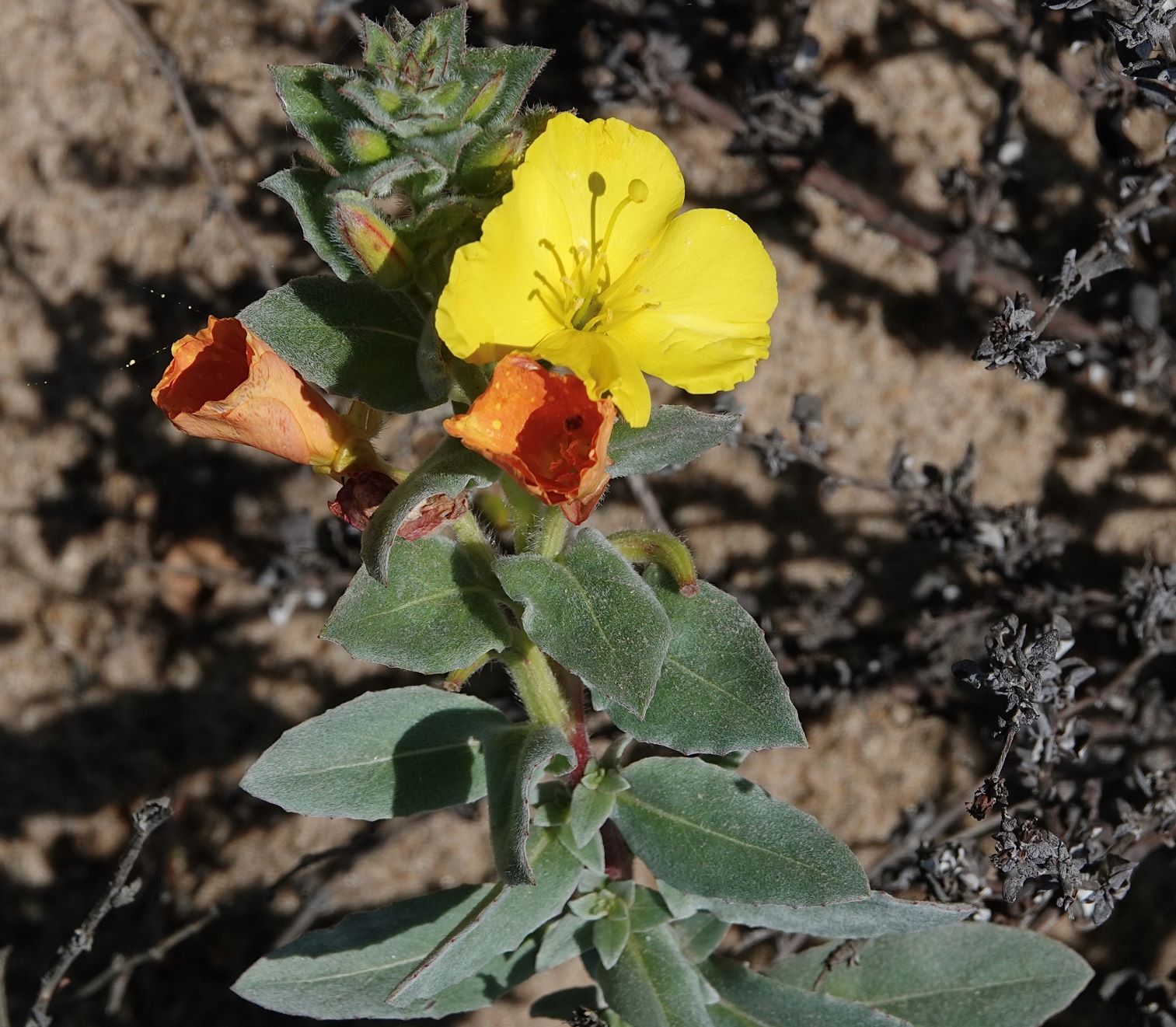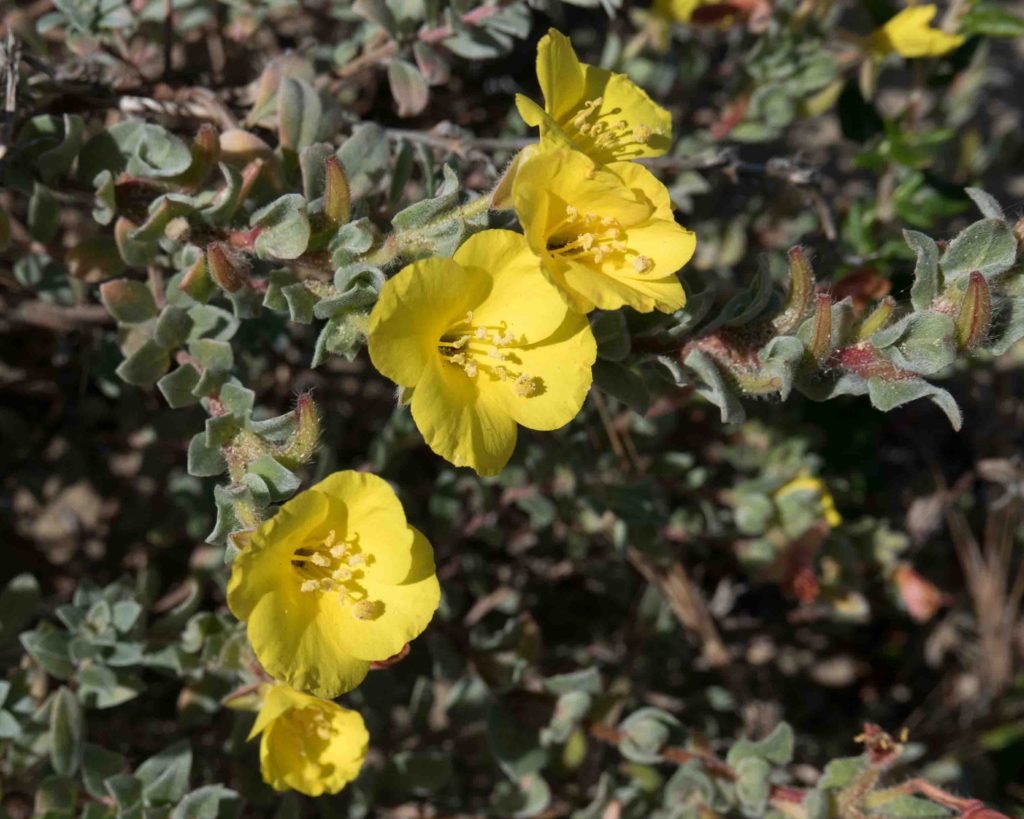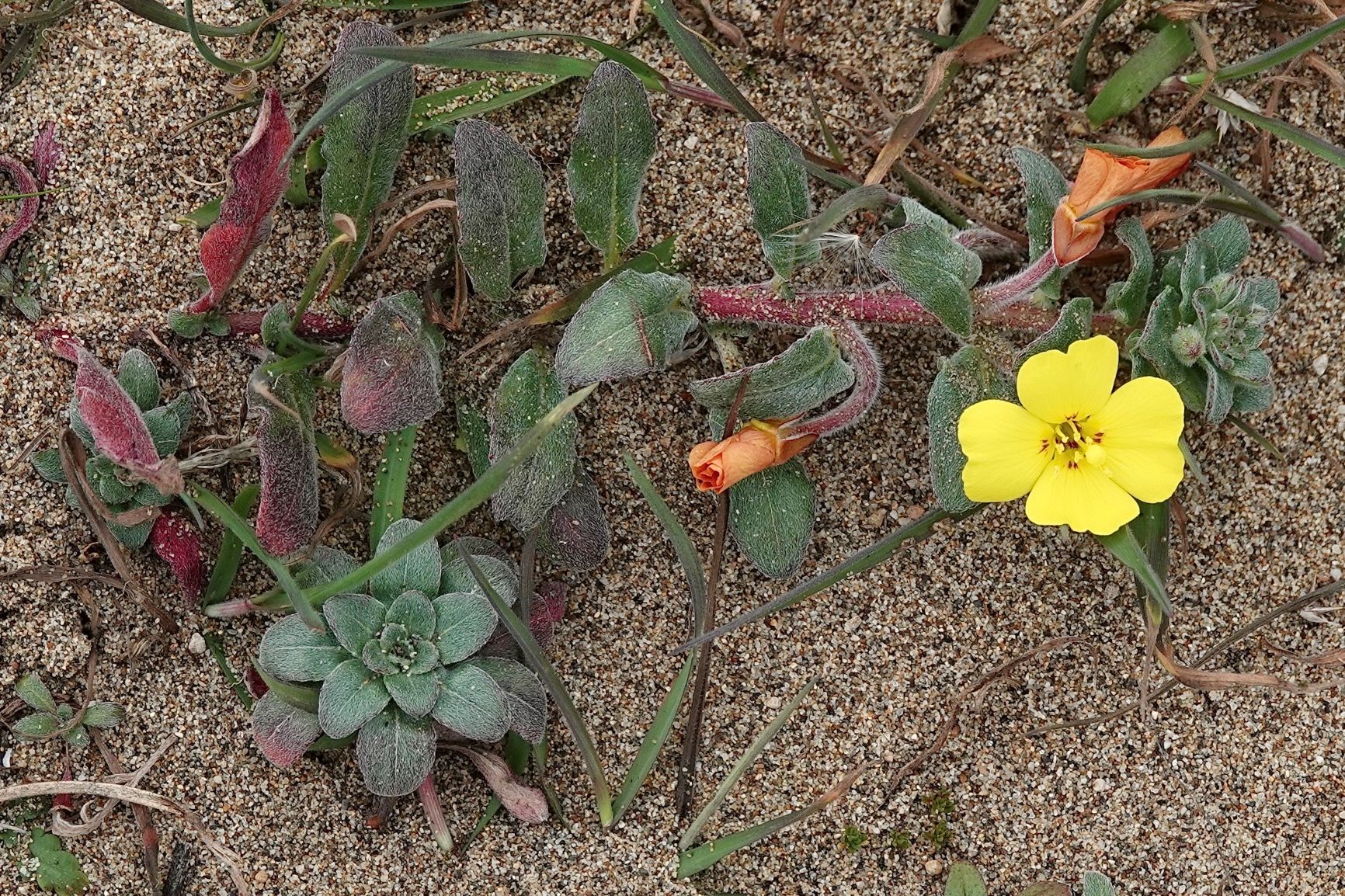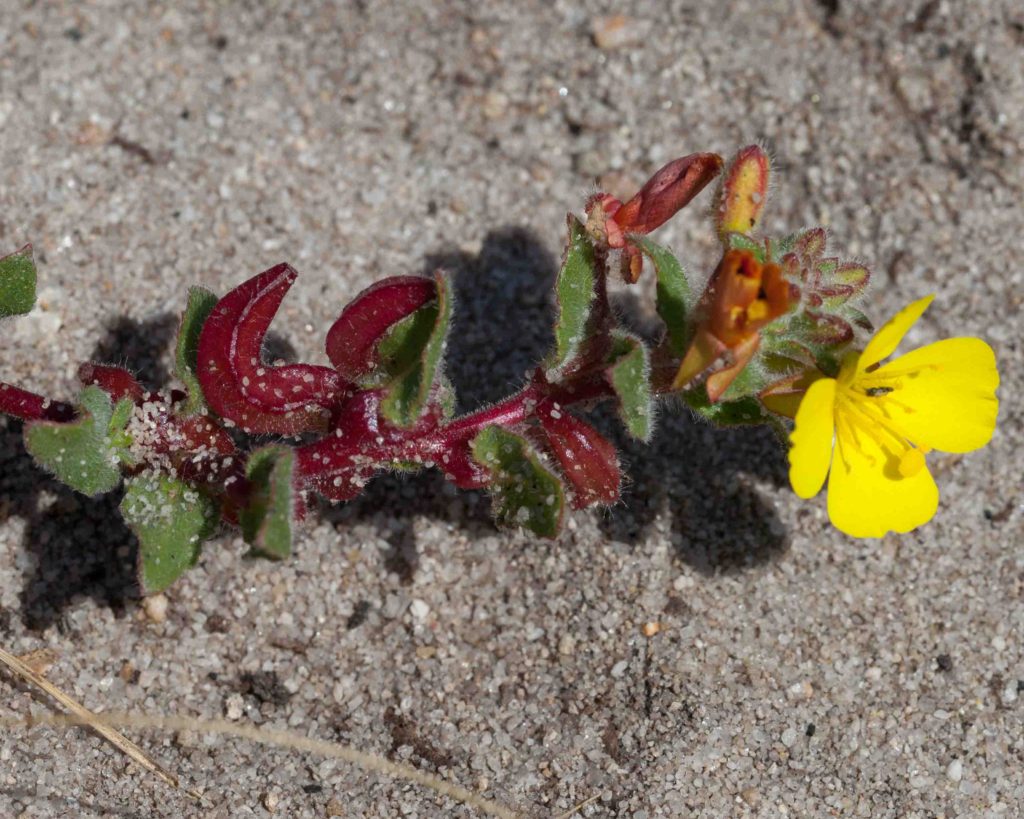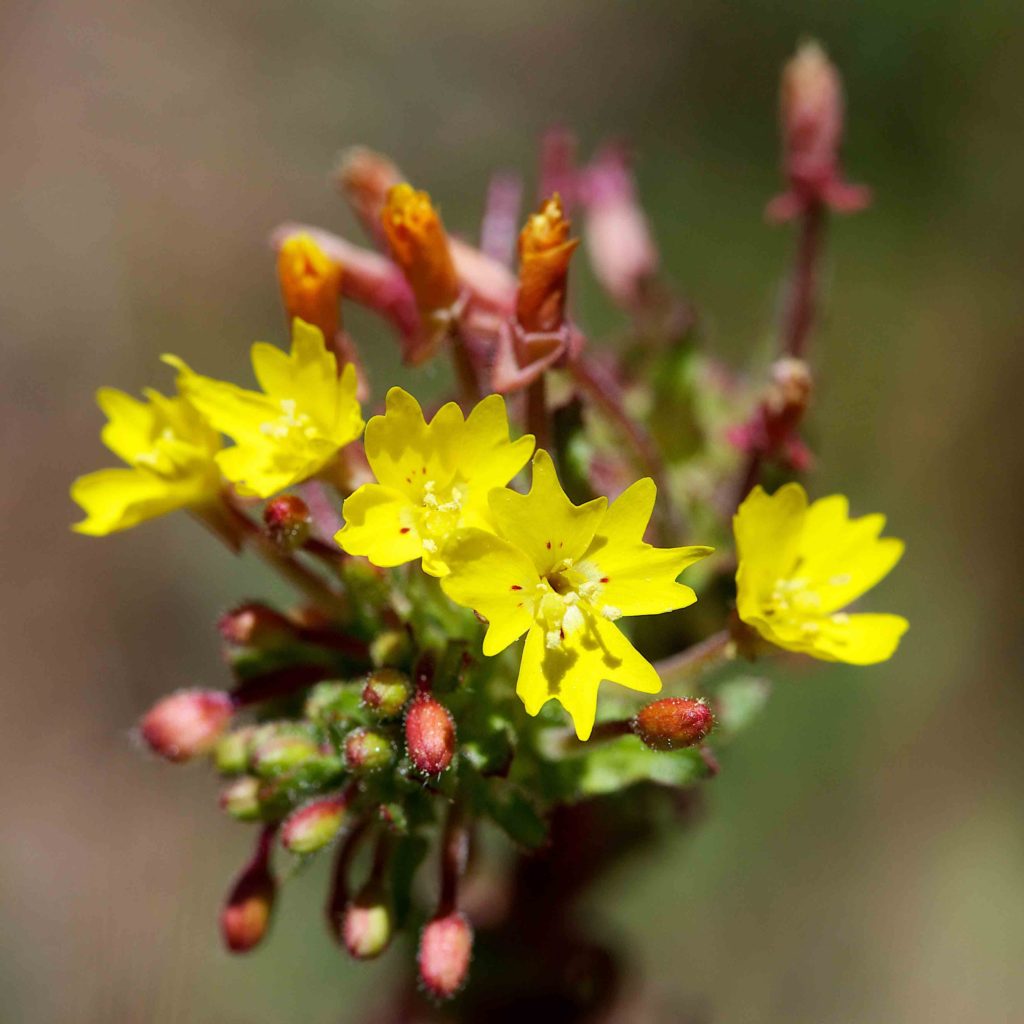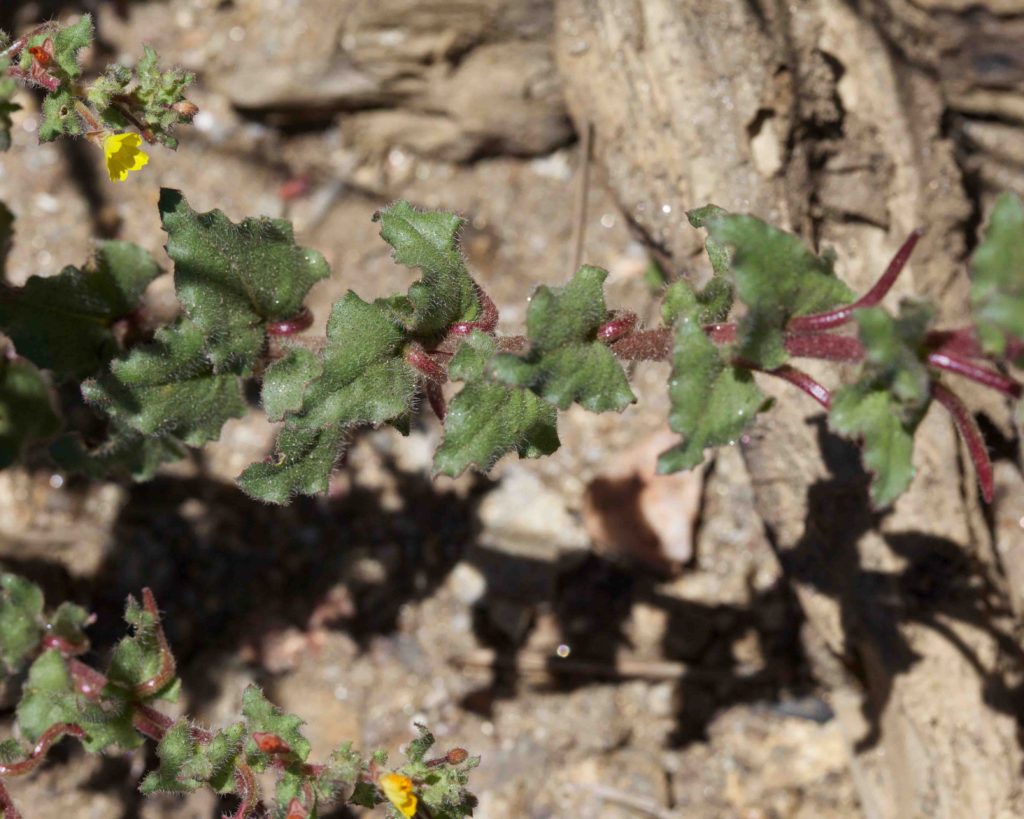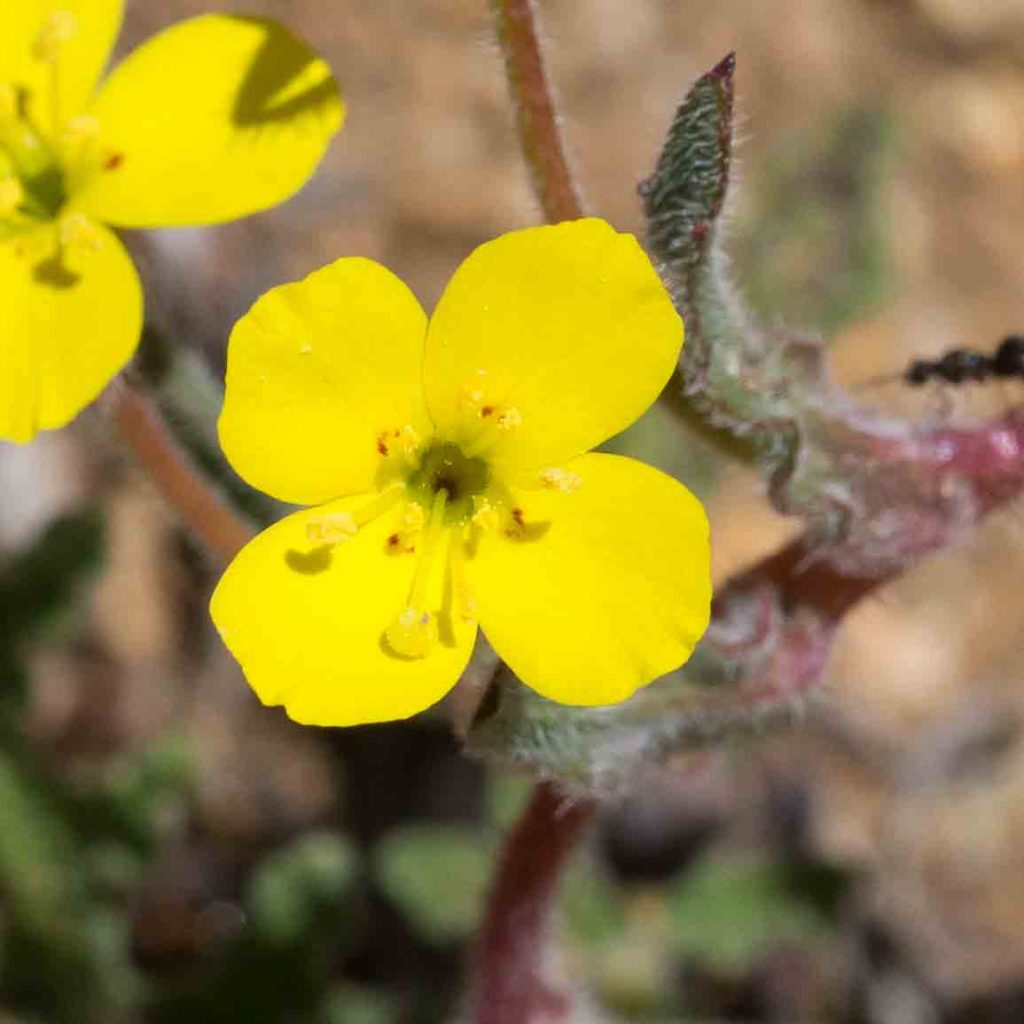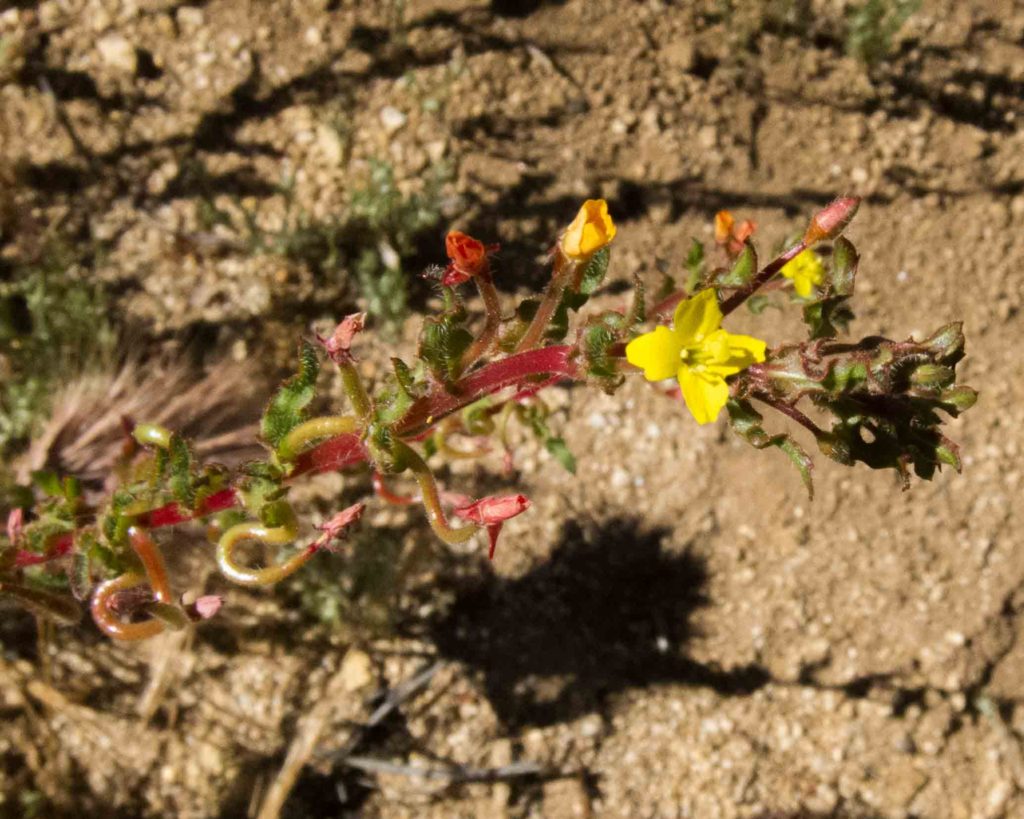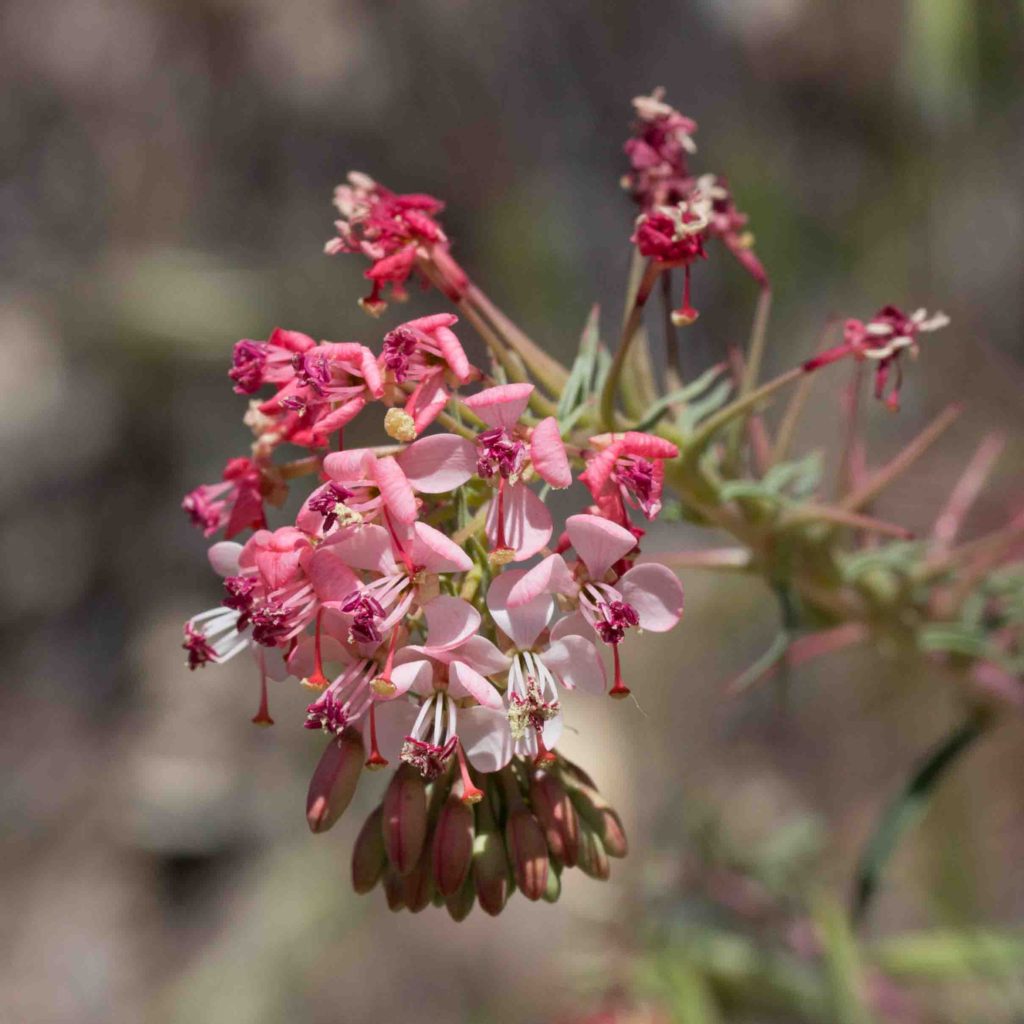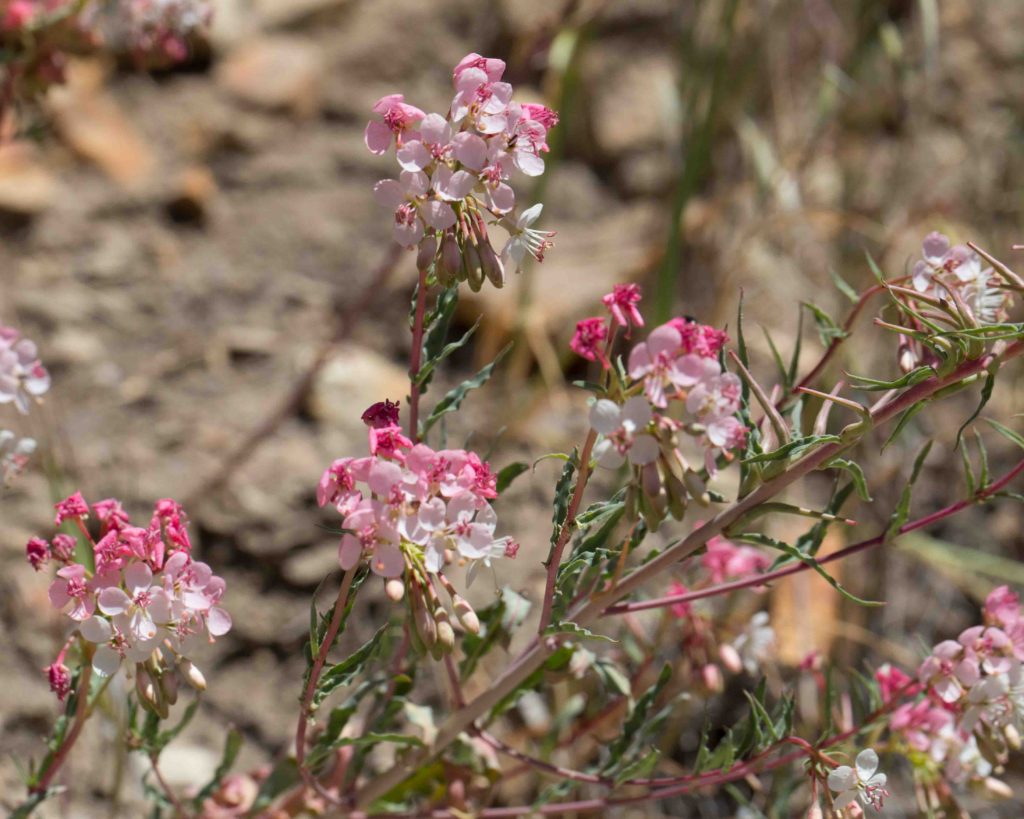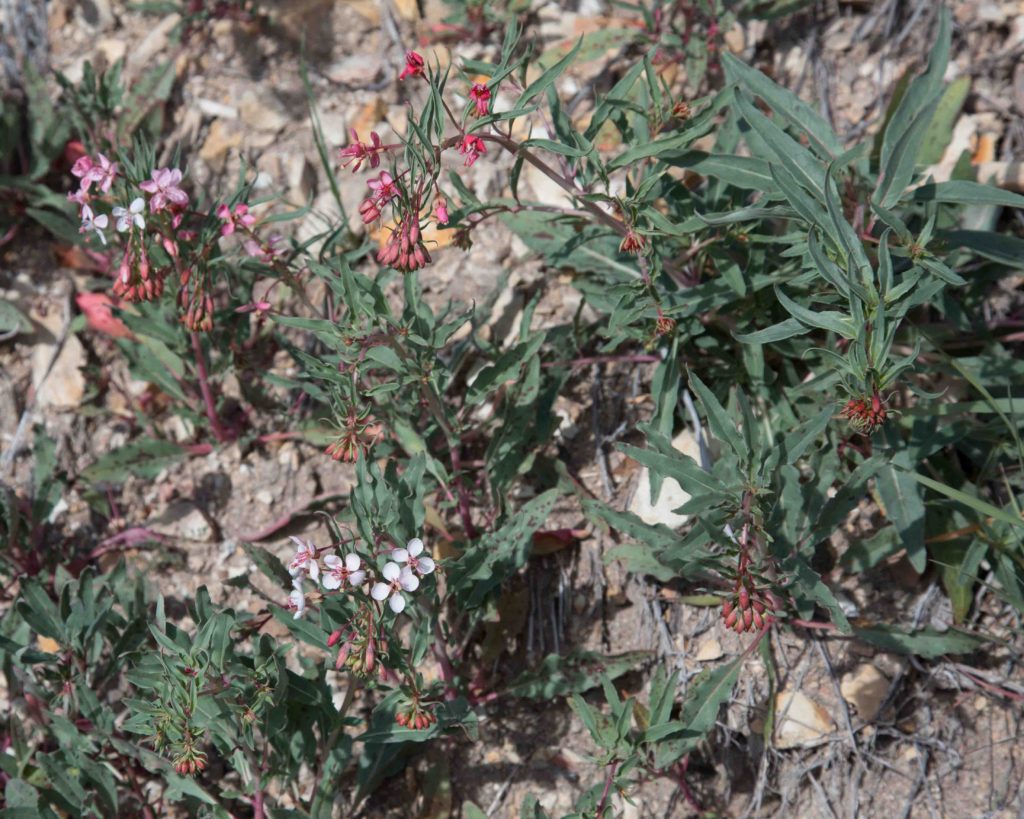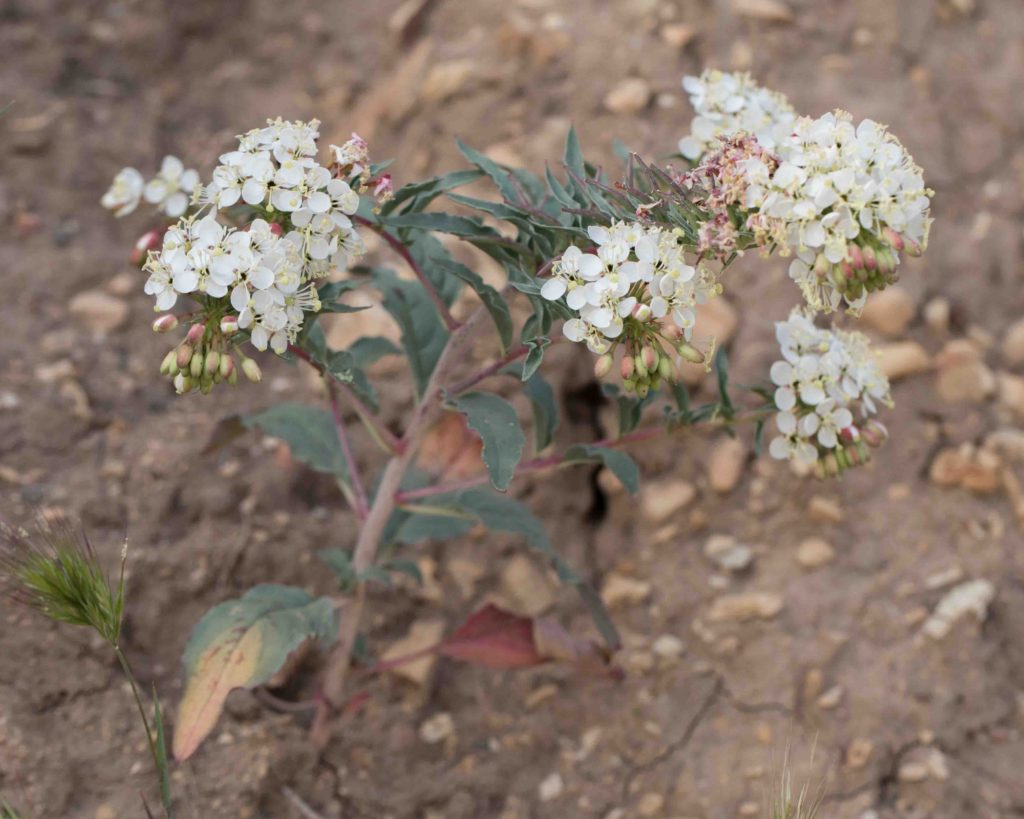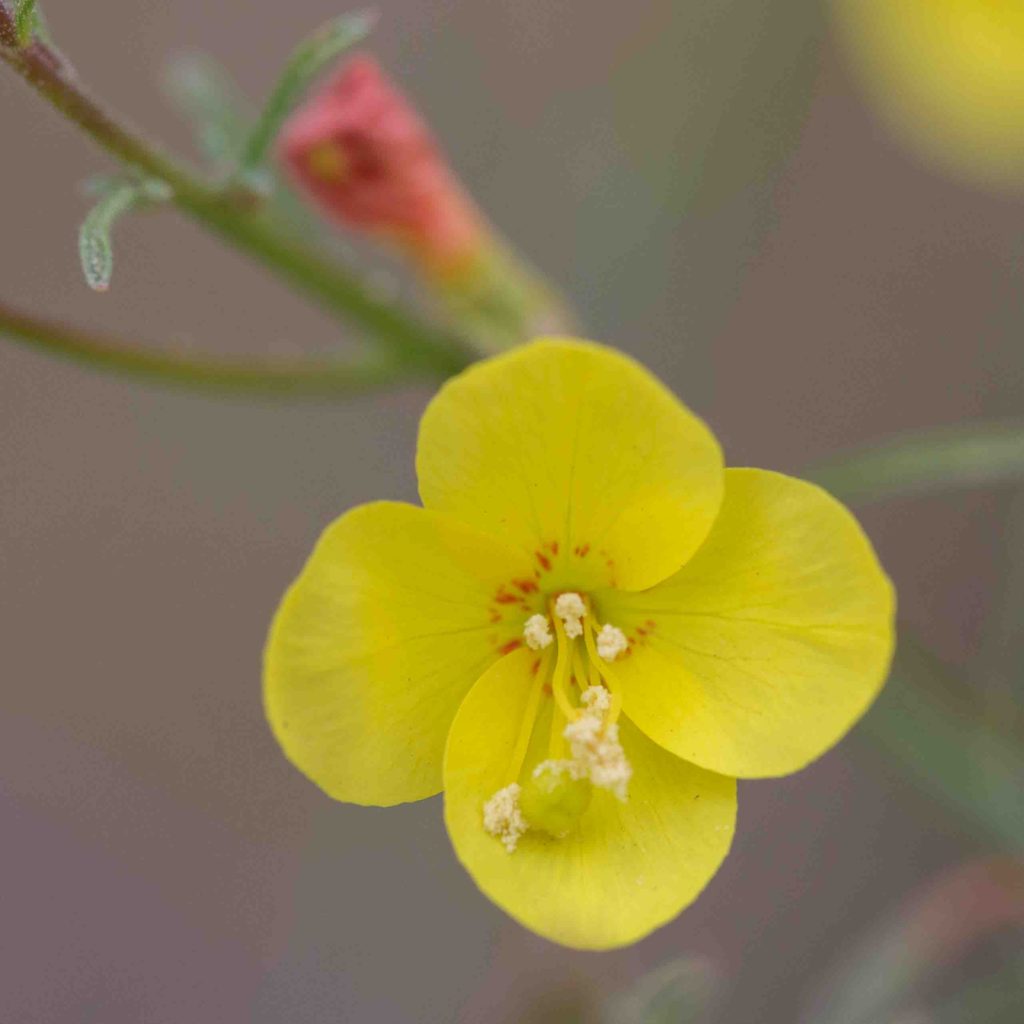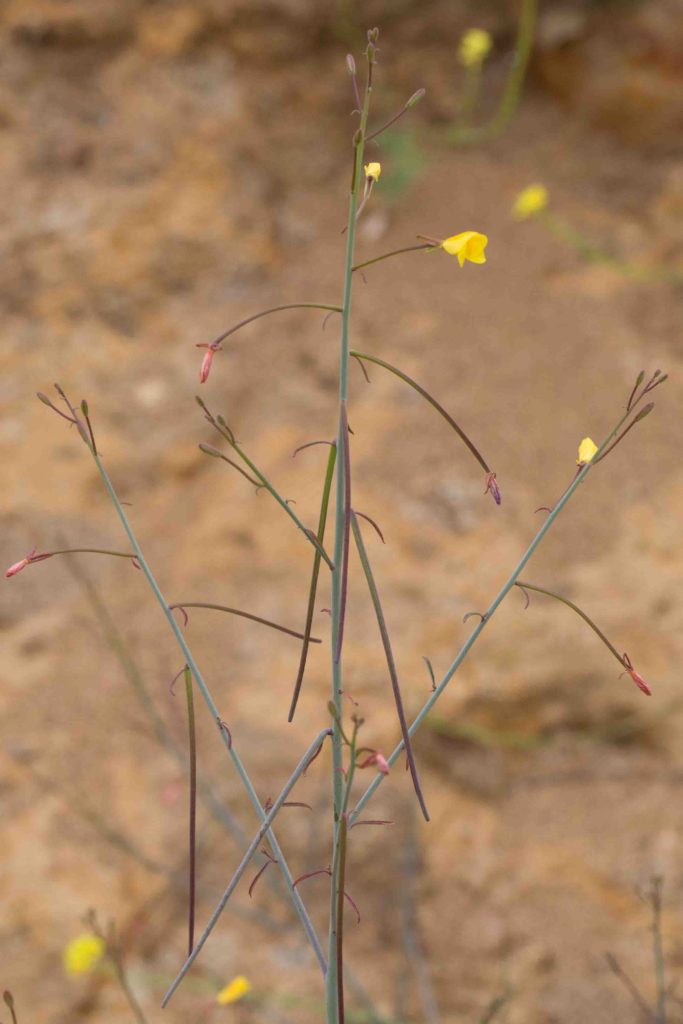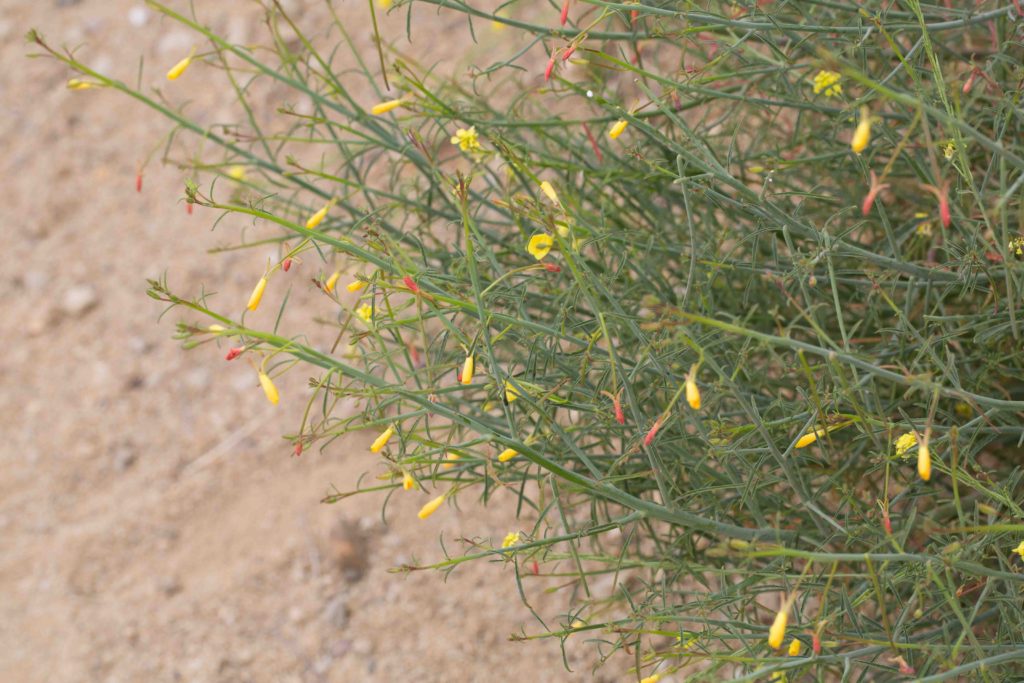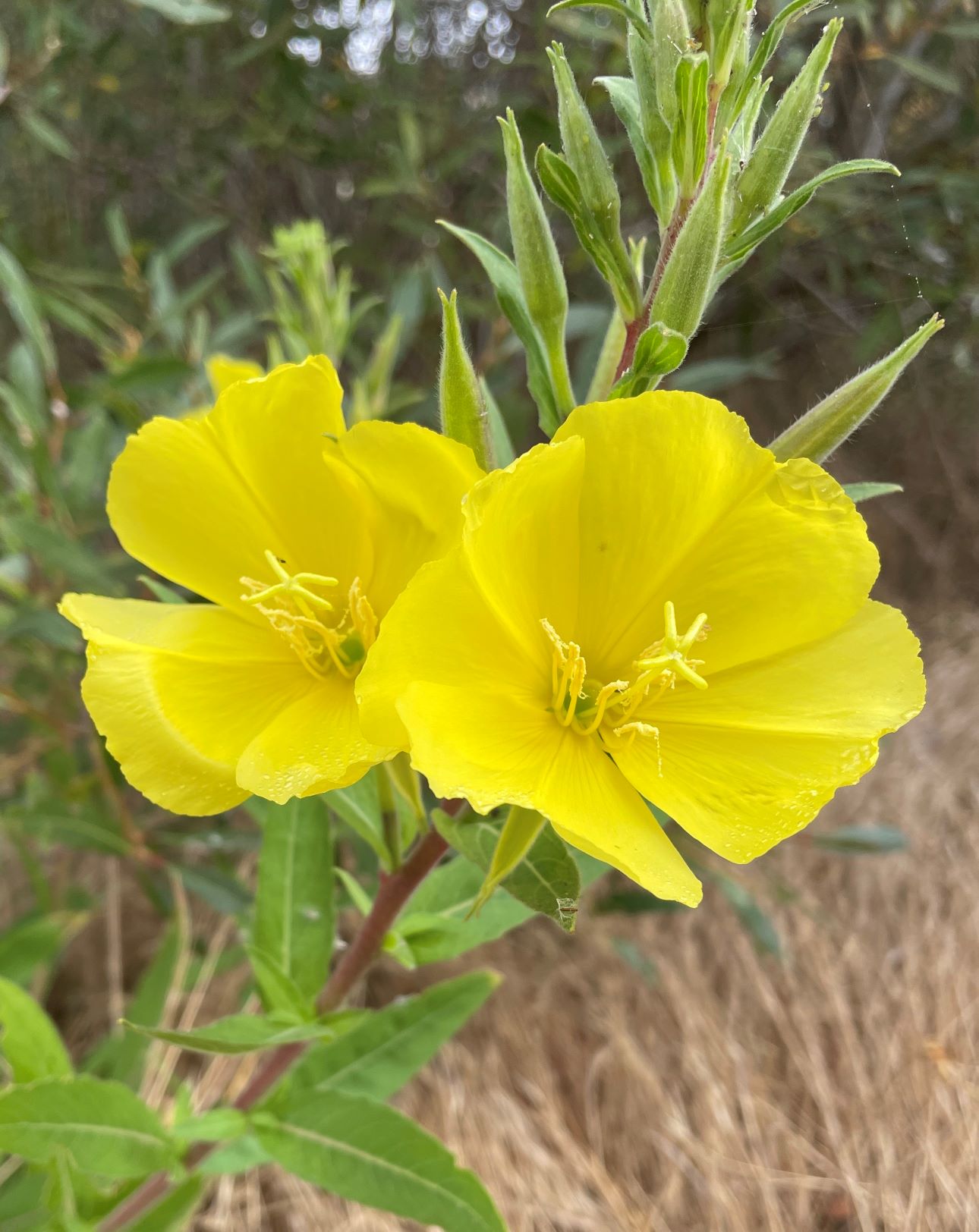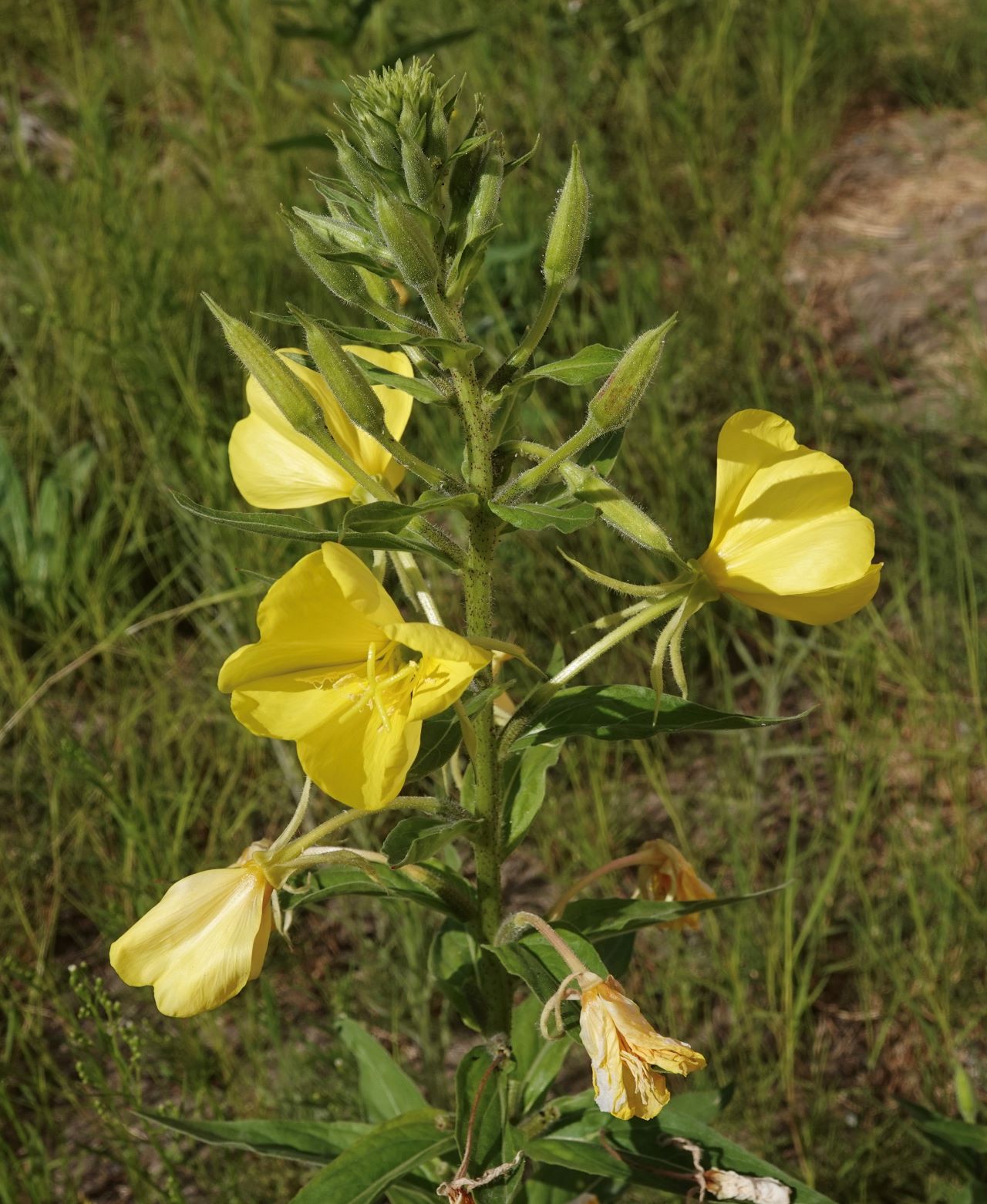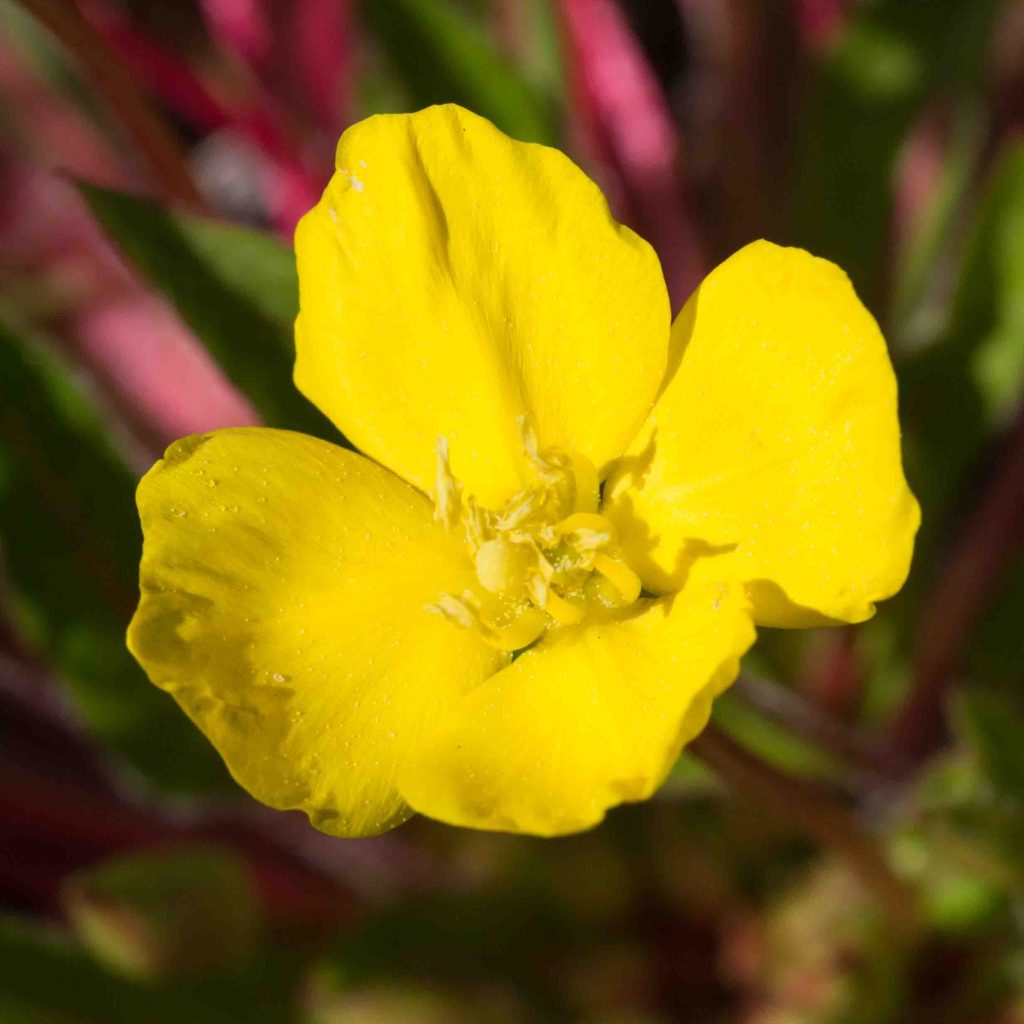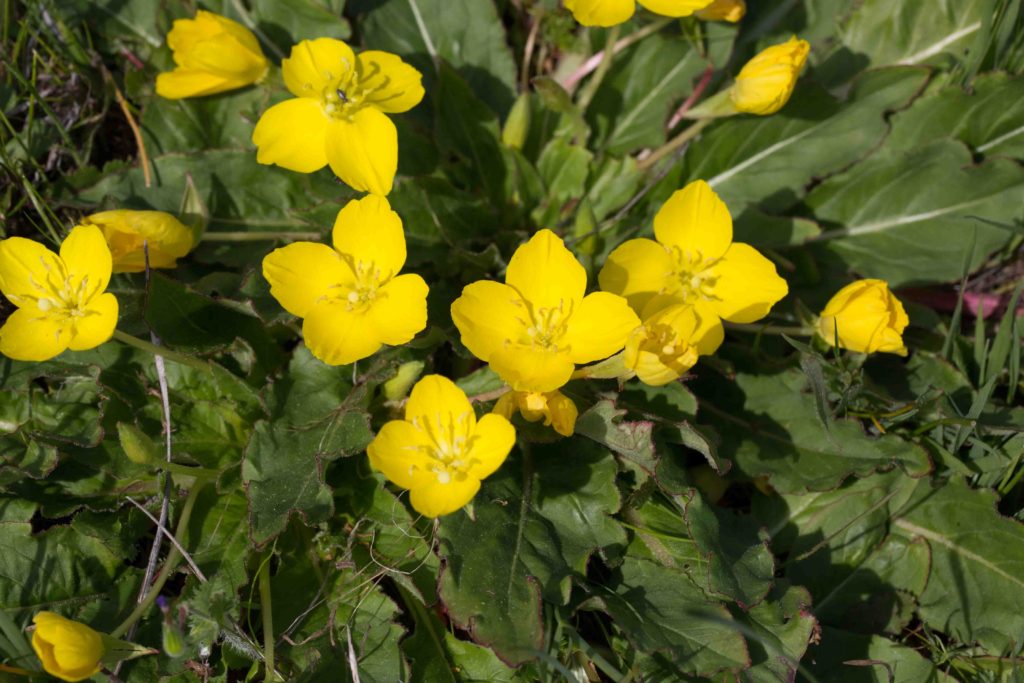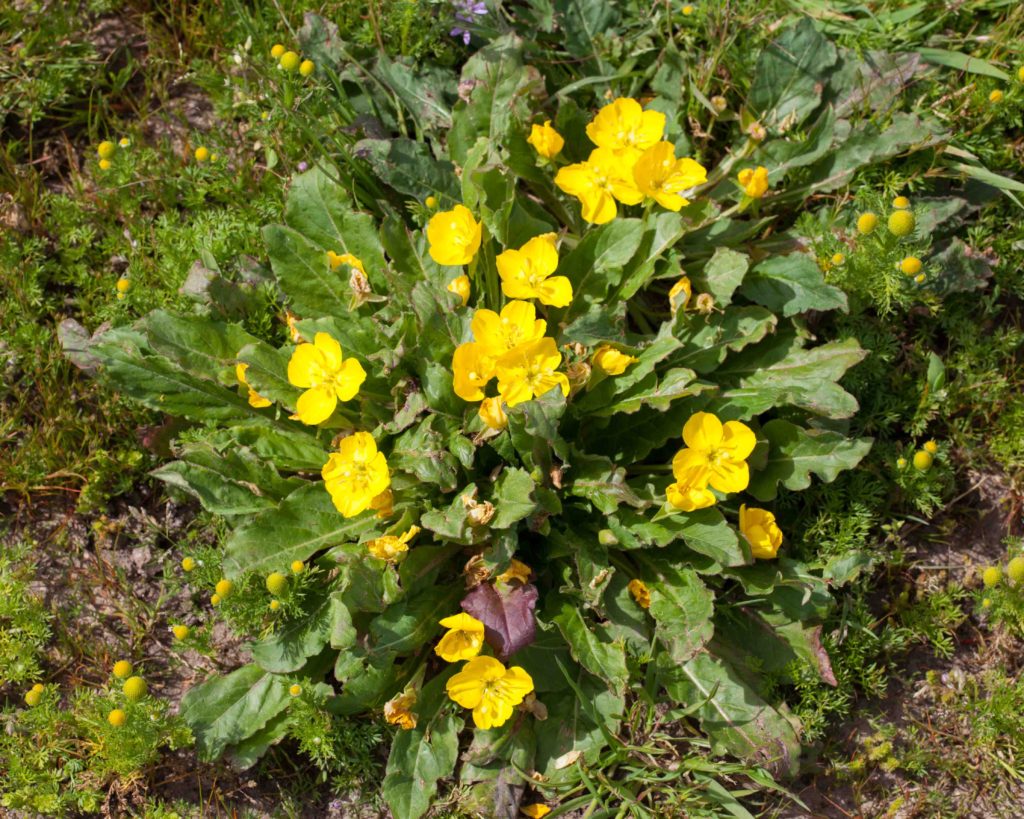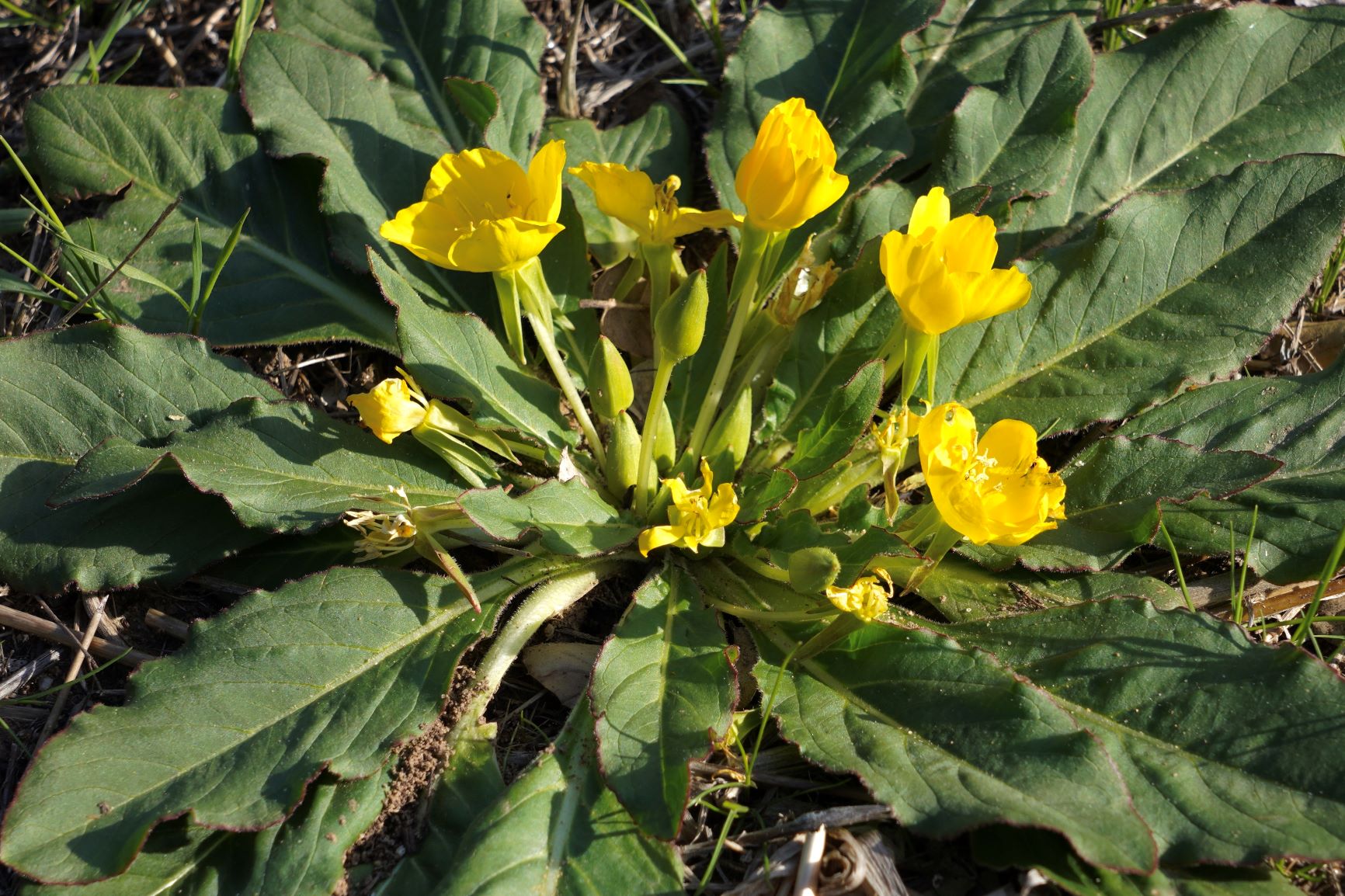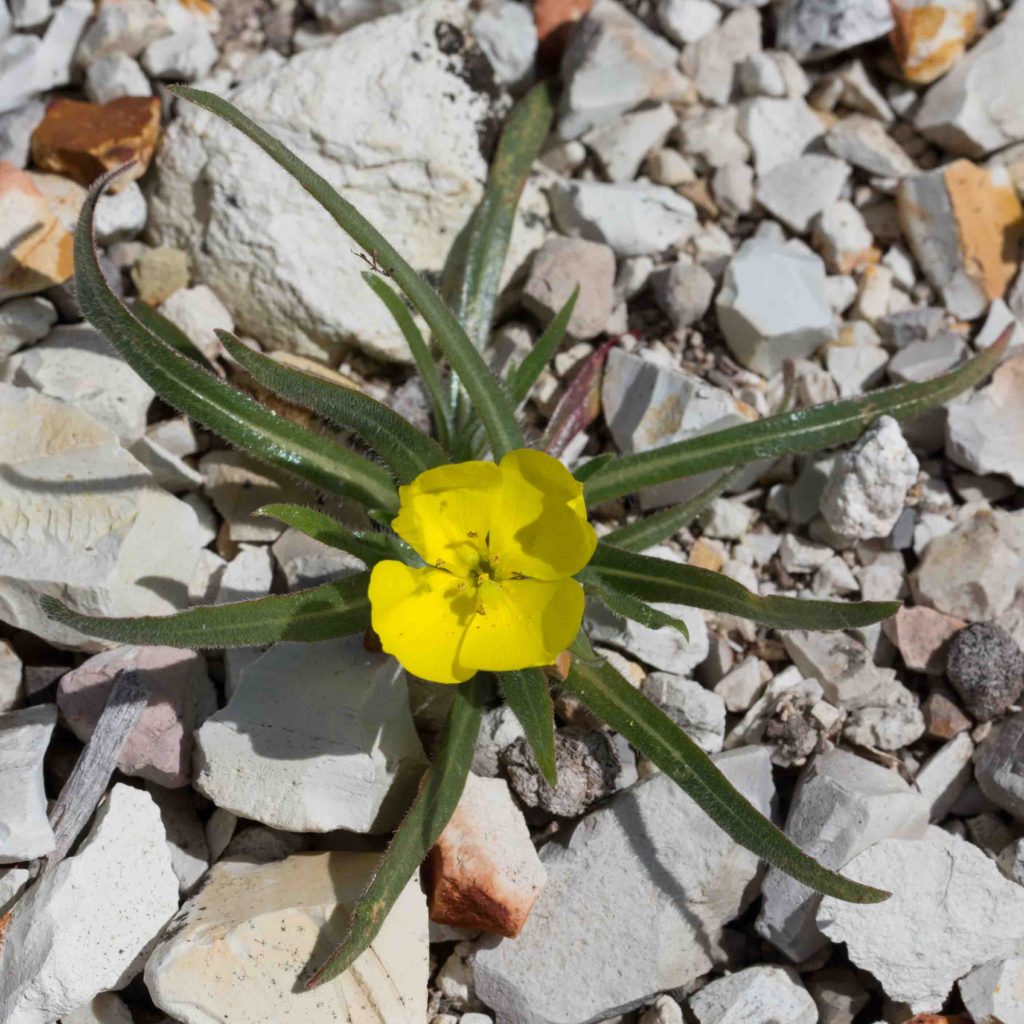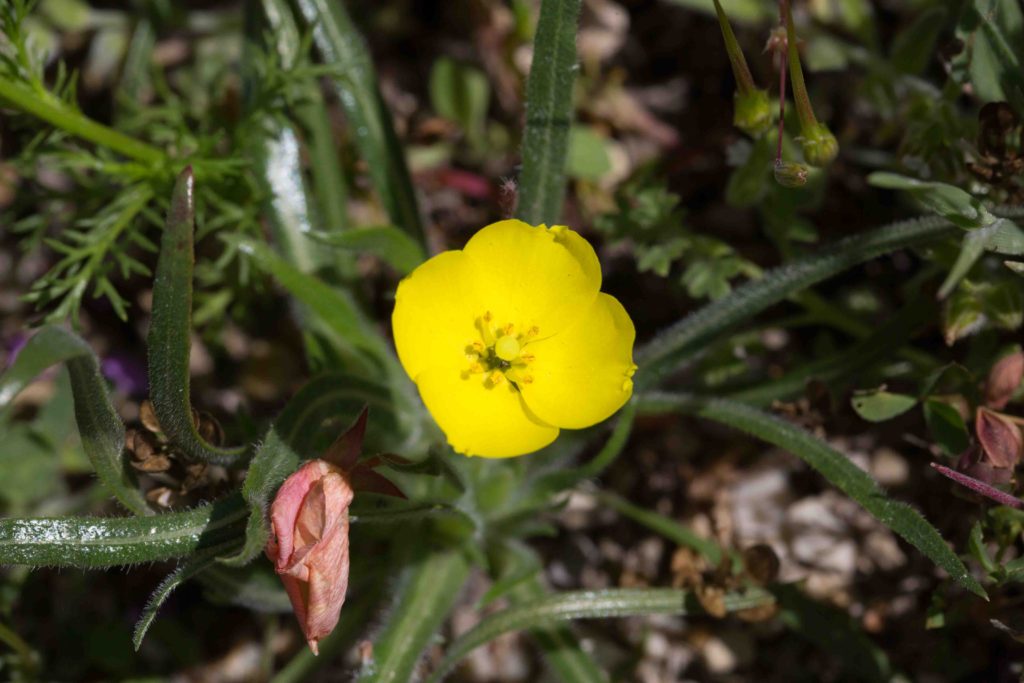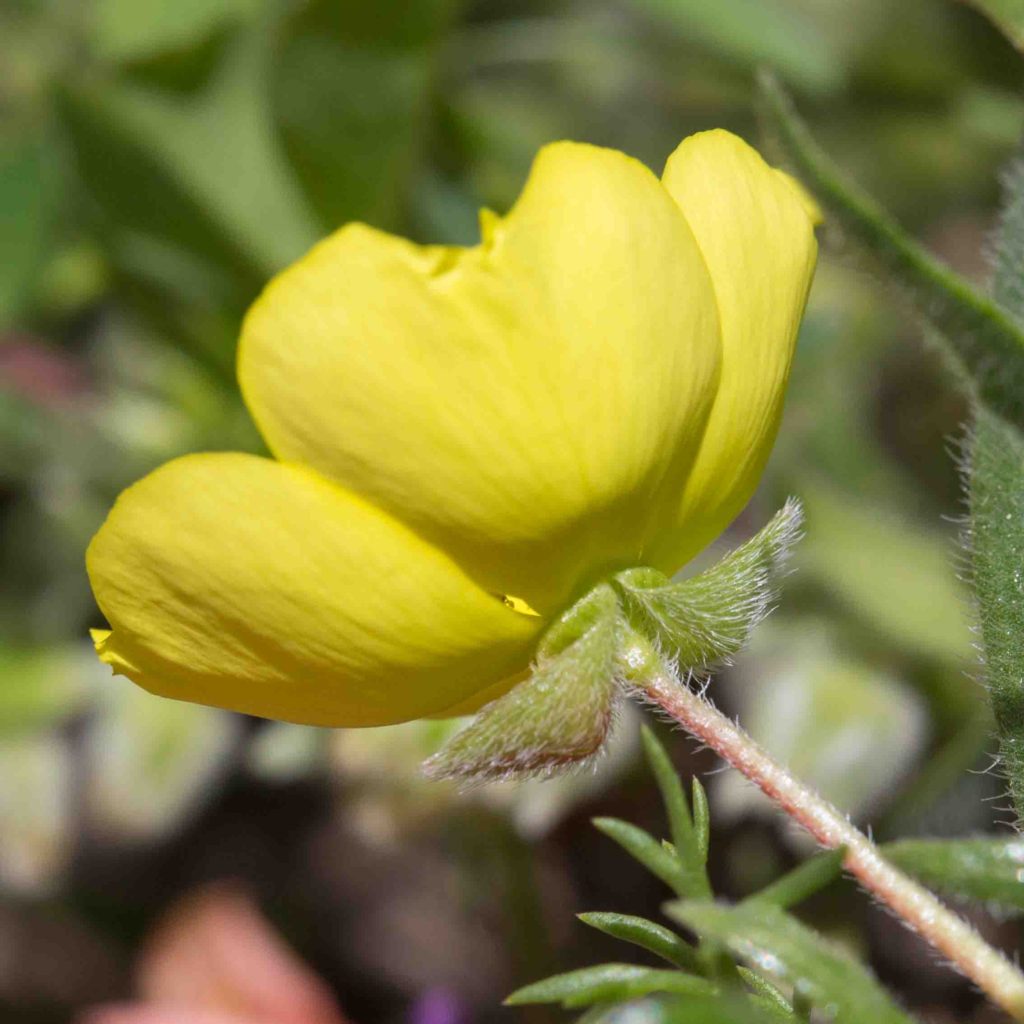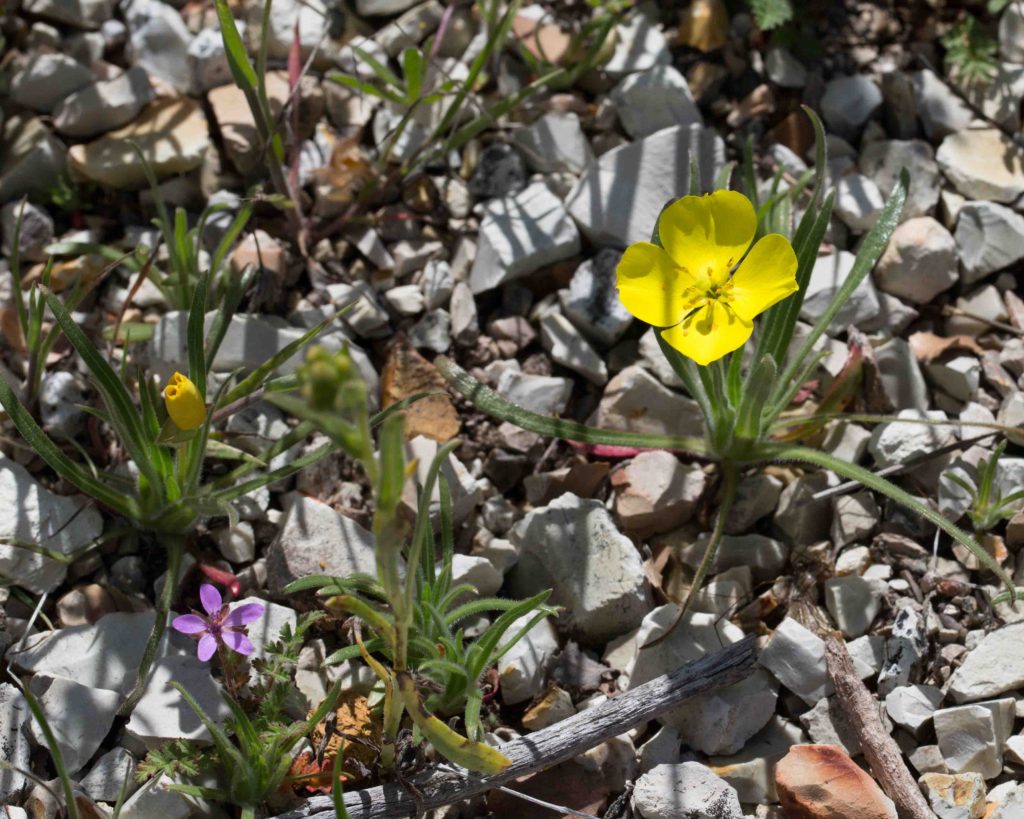Onagraceae: Evening-primrose Family — Suncups, Primroses and others
Most members of the Evening-Primrose family have 4-petaled flowers, and many of them are showy. Despite the name, they do not necessarily bloom in the evening. There is a separate family called Primrose (Primulaceae).
This page includes two genera (Camissonia and Camissoniopsis) which used to be in the same genus, but have now been separated. There are three differences between them. Camissonia has more or less straight fruits, cauline leaves only, and its flowers are on the uppermost nodes; while Camissoniopsis generally has coiled fruits, basal and cauline leaves, and its flowers are on nodes along the whole stem. Individual members of these two genera can be hard to distinguish. Pay attention to the types of hairs, possible presence of glands, and possible presence of small red spots at the base of the petals.
Contorted Suncup / Primrose – Camissonia contorta
Blooms:
Mar–June
Plant Height:
3–30 cm
Flower Size:
Small
Origin:
Native
Habitat:
Open grassland on dry, loose soil
Notes:
Despite its name, the petals of this suncup are straight to wavy, not contorted. It is similar to Sandysoil Suncup (Camissonia strigulosa, see below). But it can be distinguished by its blue-green leaves, and by the hairs on its stem, which are spreading rather than appressed. The small, bright yellow flowers have tiny red dots at the base of the petals, and are similar in appearance (if not size) to the other suncups. Also, the way the sepals are folded back from the petals is typical for this family.
Sandysoil Suncup – Camissonia strigulosa
Blooms:
May–June
Plant Height:
< 50 cm
Flower Size:
Small
Origin:
Native
Habitat:
Dunes & other sandy soil
Notes:
This is very similar to Contorted Suncup (Camissonia contorta, see above) but a little taller. It can be distinguished by its green (rather than blue-green) leaves, also by the hairs on its stem, which are short and appressed (rather than spreading).
Beach Evening-primrose – Camissoniopsis cheiranthifolia subsp. cheiranthifolia
Blooms:
Apr–Aug
Plant Height:
Stems < 60 cm
Flower Size:
Medium
Origin:
Native
Habitat:
Dunes & coastal strand
Notes:
This plant is found on or near coastal sand dunes. Its flowers are similar to those of the Camissonia, but somewhat larger, 2–4 cm across and found at the tips of the stems. Leaves are narrowly ovate to obovate and hairy. There is usually a basal rosette of leaves. Stems are creeping, leafy and reddish in color. Fruits are also reddish and noticeably 4-angled. Photos #1 and 3 by CJH.
Intermediate Suncup – Camissoniopsis intermedia
Blooms:
Mar–May
Plant Height:
< 60 cm
Flower Size:
Small
Origin:
Native
Habitat:
Shrubby slopes, often after fires
Notes:
This belongs to a group of small-flowered suncups that can be challenging to distinguish. Its flowers have 1 or 2 red spots at the base of the petals, unlike Hairy Suncup (Camissoniopsis hirtella, not shown). Also, the hairs of the inflorescence are glandular, unlike Miniature Suncup (Camissoniopsis micrantha, see below). Its fruits are 1–2 mm wide and straight to 1-coiled.
Miniature Suncup – Camissoniopsis micrantha
Blooms:
Mar–May
Plant Height:
< 60 cm
Flower Size:
Small
Origin:
Native
Habitat:
Coastal dunes and other sandy places
Notes:
This belongs to a group of small-flowered suncups that can be challenging to distinguish. Its flowers have 1 or 2 red spots at the base of the petals (not always present). Also, the hairs of the inflorescence are not glandular, unlike Intermediate Suncup (Camissoniopsis intermedia, see above). The plant is generally densely spreading-hairy. Its fruits are about 1–2 mm wide, and straight to 1-coiled.
Shredding Primrose – Eremothera boothii subsp. decorticans
Blooms:
Mar–June
Plant Height:
< 180 cm
Flower Size:
Small
Origin:
Native
Habitat:
Disturbed slopes & flats inland
Notes:
The pink and white coloring of the flowers of this primrose are unusual. The flowers are borne in clusters at the tips of slender, branching peduncles, Leaves are green or red-tinged, lanceolate to narrowly ovate.
Mustard-like Primrose – Eulobus californicus
Blooms:
Apr–June
Plant Height:
< 180 cm
Flower Size:
Medium
Origin:
Native
Habitat:
Open places in scrub & chaparral
Notes:
The 1–2.5 cm flowers with their swept-back sepals are immediately recognizable as belonging to the Evening-primrose family. They are borne on slender wand-like stems. The long (45–110 cm), slender fruits are reflexed like those of certain mustards, hence the plant’s common name. Found only in the far east and south of Monterey County, though more common further south.
Uruguayan Primrose-willow – Ludwigia hexapetala
Blooms:
May-Dec
Plant Height:
< 2 m
Flower Size:
Large
Origin:
Central and South America
Habitat:
Shallow fresh water, and shorelines
Notes:
This is an invasive, aquatic subshrub. It grows in mats, with thick white, spongy roots visible at floating nodes. On wet land, it creeps or stands erect, often climbing on other plants. Flowers are yellow with 5 or 6 petals, leaves are willow-like. Photo by CJH.
Hooker’s Evening-primrose – Oenothera elata subsp. hookeri
Blooms:
June–Sept
Plant Height:
< 120 cm
Flower Size:
Large
Origin:
Native
Habitat:
Moist places, ocean bluffs, disturbed areas
Notes:
This is a classic evening-primrose, with its large, bright yellow flowers, strongly reflexed sepals and long, pointed buds. Stems are conspicuously leafy. Flowers open in late afternoon, and bloom until the following morning, when they wilt and turn orange to reddish. Photos #1 and 3 by CJH.
Suncups / Golden Eggs – Taraxia ovata
Blooms:
Mar–June
Plant Height:
< 10 cm
Flower Size:
Large
Origin:
Native
Habitat:
Grassy meadows near coast
Notes:
This is a low-growing plant, widespread in grassy areas in early spring. It has a dense basal rosette of oval to lanceolate leaves, with prominent pale central veins, and bright lemon-yellow flowers with 8 long stamens. What appears to be a long pedicel is actually a sterile extension of the ovary, protecting the fertile ovary from the unwanted attentions of grazing animals. Photo #4 by CJH.
Slender-flowered Primrose / Hill Suncup – Tetrapteron graciliflorum
Blooms:
Mar–April
Plant Height:
Prostrate
Flower Size:
Large
Origin:
Native
Habitat:
Open or shrubby slopes in grassland.
Notes:
A low-growing plant, like Suncups (Taraxia ovata, see above), and with similar flowers. The stem is very short (< 25 mm), and the seeds are 4-winged (hence the plant’s scientific name). It is most easily recognized by its narrow, linear or oblanceolate leaves. The plant is densely spreading-hairy. Most often found in the interior and south of the county, though also present on Fort Ord.
